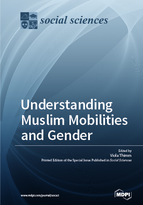Understanding Muslim Mobilities and Gender
A special issue of Social Sciences (ISSN 2076-0760).
Deadline for manuscript submissions: closed (15 June 2017) | Viewed by 75068
Special Issue Editor
Interests: gender relations and intersectionality; kinship and family networks; identity and identity politics; Islam and its socio-cultural entanglements; cultural practices of mobility; educational research; consumer culture and consumption; cultural practices in Southeast and Western Asia
Special Issue Information
Dear Colleagues,
Submissions are invited for a Special Issue on Muslim mobilities and gender in national and transnational contexts. For this Special Issue, we are particularly interested in works that incorporate historical and socio-political understandings of Muslim pilgrims, tourists and migrant mobility and settlement. Research that employs interdisciplinary analyses of contemporary gender orders, norms and practices in this regard, as part of a net of social relations organizing power and inequality, are particularly welcome.
The goal of this Special Issue is to advance the literature on how Muslim religious conceptions of travel and movement intersect with gender. Contributions might address, for example, how Muslim perceptions of space and place influence mobility and are influenced by gender; how concepts of travel and mobility are negotiated by Muslim women and men; how religious beliefs, institutions, practices, and discourses shape the spatial experiences of Muslim women and men; how theorizations of pilgrimage, tourism, migration and other forms of Muslim travel can be grasped with a gender optic; or any other questions that engage the reciprocal influences among Islam, mobility, gender, and the broader society. Articles can be theoretically or empirically driven, should be aimed at a broad, interdisciplinary audience, and should critically examine questions at the intersection of Islam, mobility, and gender. Our aim is a collection from a wide range of disciplines (e.g., anthropology, sociology, religious studies, Islamic studies, gender studies, geography, and education) that brings together a variety of emergent disciplinary and interdisciplinary perspectives on and methodological approaches to these issues at global and local scales.
Dr. Viola Thimm
Guest Editor
Manuscript Submission Information
Manuscripts should be submitted online at www.mdpi.com by registering and logging in to this website. Once you are registered, click here to go to the submission form. Manuscripts can be submitted until the deadline. All papers will be peer-reviewed. Accepted papers will be published continuously in the journal (as soon as accepted) and will be listed together on the special issue website. Research articles, review articles as well as short communications are invited. For planned papers, a title and short abstract (about 100 words) can be sent to the Editorial Office for announcement on this website.
Submitted manuscripts should not have been published previously, nor be under consideration for publication elsewhere (except conference proceedings papers). All manuscripts are thoroughly refereed through a double-blind peer-review process. A guide for authors and other relevant information for submission of manuscripts is available on the Instructions for Authors page. Social Sciences is an international peer-reviewed open access monthly journal published by MDPI.
Please visit the Instructions for Authors page before submitting a manuscript. Submitted papers should be well formatted and use good English. Authors may use MDPI's English editing service prior to publication or during author revisions.
References
Ahmed, Nilufer (2016). Family, citizenship and Islam: the changing experiences of migrant women ageing in London. Aldershot: Ashgate.
Fábos, Anita and Isotalo, Riina (eds.) (2014). Managing Muslim Mobilities: Between Spiritual Geographies and the Global Security Regime. New York: Palgrave Macmillan.
Falah, Ghazi-Walid and Nagel, Caroline (2005): Geographies of Muslim Women: Gender, Religion, Space. New York: Guilford Publications, 2005
Secor, Anna J. (2002). The Veil and Urban Space in Istanbul: Women’s dress, mobility and Islamic knowledge. Gender, Place & Culture: A Journal of Feminist Geography 9(1): 5–22.
Shanneik, Yafa (2012). Religion and Diasporic Dwelling: Algerian Muslim Women in Ireland. Religion and Gender. 2(1), pp.80–100. DOI: http://doi.org/10.18352/rg.30
Silvey, Rachel (2014). Transnational Domestication: State Power and Indonesian Migrant Women in Saudi Arabia. CLARA Working Paper, No. 17.
Werbner, Pnina (2015). Sacrifice, Purification and Gender in the Hajj. In: Mols, L. und M. Buitelaar (eds.): Hajj: Global Interactions through Pilgrimage, pp. 27-39. Leiden: Sidestone.
Keywords
- Spirituality of travel
- Religious travel
- Gender as social structure
- Pilgrimage, tourism, and migration
- Space and place
- Intersectionality






